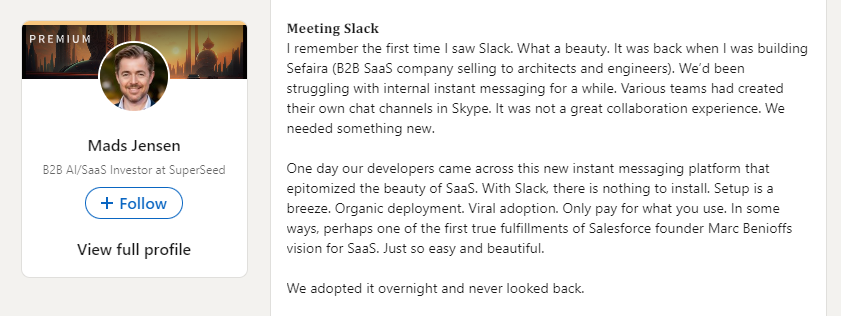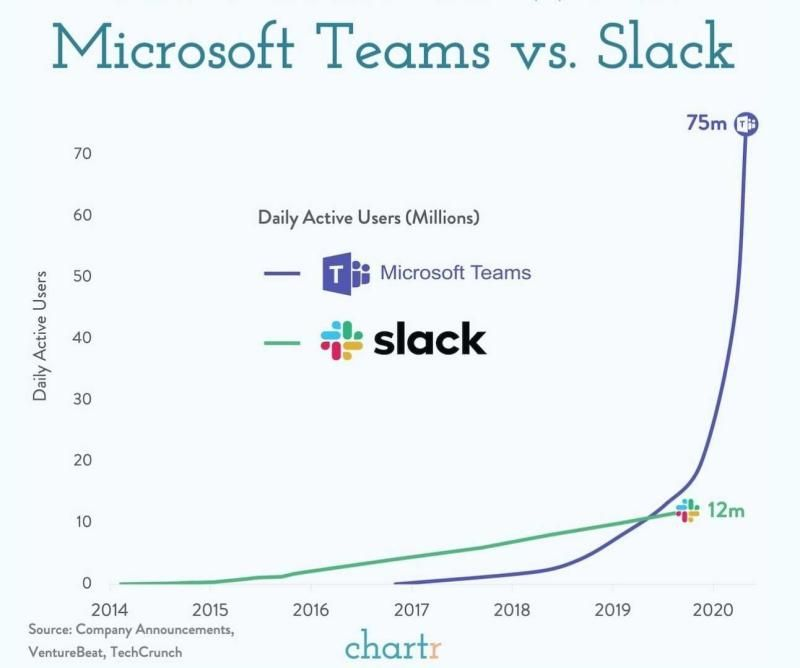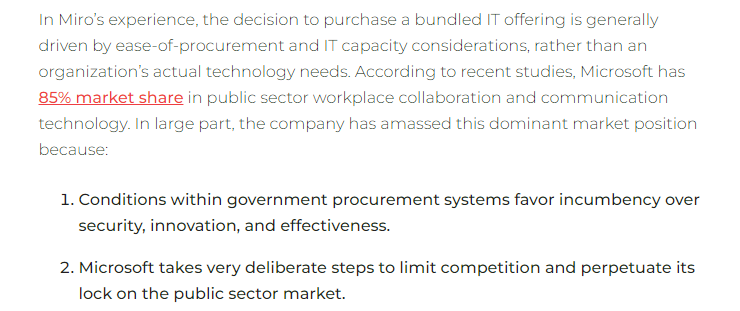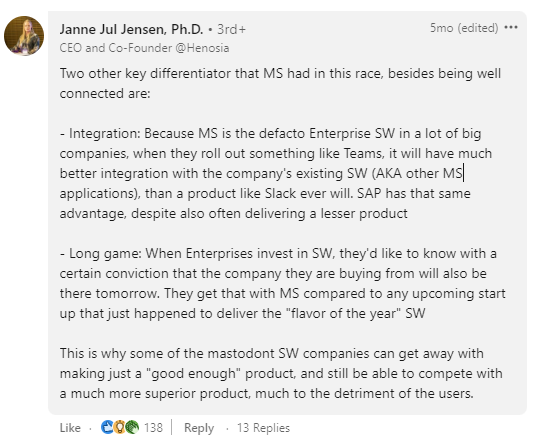Does the best product always win?
That’s a tough question to answer, but in my experience, the best product doesn’t always win. Below, I’m sharing some fantastic examples of why that’s the case.
Slack vs. Microsoft Teams
We’re going to look into a short article from Mads Jensen about whether or not the best product always wins. Here, we’ll see that another factor actually determines whether your product will win or not — distribution.

Slack’s Domination
Jensen shares his experience with Slack, which they first discovered when their B2B SaaS company was struggling with instant messaging.
Around 10 years ago, people simply sent emails when they wanted to talk to each other. While you may not realize it in 2023, internal instant messaging wasn’t a constant just a decade ago.
Slack was a fantastic product back then, and it still is now. Jensen and his loved its features — from the easy setup to its viral adoption.
Four years later, Microsoft launched Teams.
At that time, Slack CEO Stewart Butterfield was so happy to see further competition in the market. He knew how much lead they had and how much better their product was.

In a full-page ad in the New York Times, Butterfield “welcomed” Microsoft. According to Jensen, the letter included plenty of “friendly advice,” but the subtext wasn’t subtle.
Essentially, Butterfield said that they were first to market, and they had the best functionality. They were going to stay ahead of Microsoft Teams at all costs.
This confidence wasn’t unfounded, either. Slack had such a lead that it was so organically embedded into the market. It couldn’t simply lose to Teams — or could it?
Microsoft Teams Takes The Lead
Years later, Slack domination ends. Let look at the graph below:

This graph shows us that Slack had a massive head start against Teams. However, it also shows that Teams has had parabolic growth. The difference in user base by 2020 was simply staggering, with Teams taking the lead.
What happened?
Microsoft’s Two-Pronged Strategy
Everything boils down to bundling and distribution.
Even though Slack had the headstart and was by far the better product, Microsoft’s sheer distribution scale did the trick. This meant that even if they brought a subpar product to the market, they could get it out to their users more easily.
As of today, Slack has been bought by Salesforce, which will take the product internally and build their distribution channel and distribute it from there.
Meanwhile, Microsoft is so far ahead, and their feature set has grown so much that it’s debatable whether or not Slack is still the better product.
My personal opinion is that Slack is superior to Teams. However, the market likes Teams better because of its distribution channel. This goes to show that even if you’ve got an inferior product, capturing the market means you can sell them what you’ve got.
Product Bundling
Here’s a quick summary of Microsoft 365:

If you remember about 5 to 10 years ago, Word was a standalone product. The same was true for OneDrive,and other Microsoft products, and they had built-in distribution channels for these items.
When they launched Teams, they bundled everything together. That was how we ended up with the Microsoft 365 suite that we know today.
As they brought the product to the market, Microsoft didn’t charge much for Teams. In fact, they gave it away for free. At the end of the financial year, they simply bumped up the cost of the bundle. As a result, users might not have noticed it, but Teams was already a part of the bill they were paying.
Microsoft did a similar thing to OneDrive. It used to be a standalone product, but they bundled it with Microsoft 365.
Is This Anti-Competitive?
Now, you might think that Microsoft’s bundling strategy is an anti-competitive practice. And that’s 100% correct.
In fact, there have been multiple EU antitrust concerns around this bundling process.
Essentially, people claimed that Microsoft was releasing subpar products, bundling them together, and releasing them covertly into existing clients, essentially blocking out competition. Even if there was a better product for a cheaper price in the market, Microsoft would win the market.
Circling back to our original question: is the better product always going to win the fight?
Well, it doesn’t seem to be the case. Perhaps having better product lead growth isn’t always the best way to secure the top spot in the market.
Maybe, traditional sales methods or partnering with someone for distribution is the better way to get there.
Let’s dig deeper into this bundling approach.
The Pros And Cons of Bundling
I’m sharing this Miro article that discusses the approach’s pros and cons. While this one’s focused on public sector clients, public and private sectors generally mirror each other. Here’s an excerpt from the article:

The Benefits
Take note of the first point.
Change in any organization is tough, but if companies simply get Microsoft Teams as part of the bundle, they have nothing much to change.
Using it will fall under their same process, and it’s easy to roll out — there’s no actual change process to implement. As a result, incumbency generally wins.
Now, for the second point: Microsoft already has agreements with various companies.
Getting your foot in the door is challenging, but Microsoft is already there. They’ve got licensing deals and security in place, and it seems that they’re only making the bundle bigger to charge a bit more. Because of that, the bundling model becomes an attractive proposition for companies.
The Downsides
There are multiple downsides to Microsoft’s approach. The articles enumerates them in the following:

First, the cost. Microsoft’s bundles are more expensive than competitors, which can offer cheaper and more effective solutions.
However, as we discussed, Microsoft’s bundles are easier to implement. But if you choose a competitor’s bundle, you’ll exert more effort changing your process.
Second is security. Since the entire rollout process is lax, it compromises security. On the other hand, if you use four different products, you also have four different surface areas — greater exposure to risk.
Third, one size fits all. Because OneDrive, Teams, and the entire Microsoft 365 suite are so easy to use and functional out of the box, generalists take the bundle on even if it doesn’t fit their use cases perfectly. They just take it anyway because it’s easy.
And finally, the lack of innovation. This summarizes the whole point of this discussion here. The function that Microsoft gives customers is good enough. It’s not quite the best nor the cheapest, but it’s good enough to roughly do what they want.
Remember that graph from earlier? That’s what people are doing. The product is easy to adopt and roll in, so they use it.
Distribution Partners
Another key reason why Microsoft Teams has been widely adopted is the business’ distribution strategy.
When launching your product, you must have a distribution partner that can help you quickly get your product to market. That’s the key point of this discussion: having the best product isn’t enough. There has to be a distribution strategy behind it, and Microsoft knows that.
Let me share the following screenshot of a LinkedIn post from Janne Jul Jensen, where she shares two interesting points.

The first point is about integration, which talks about why Microsoft is the de facto solution in a lot of big companies.
This is 100% true. People already use the Office suite, so they’re obviously going to use Teams.
Slack does have integration with Office, too, but it’s not native out of the box (it’s getting better these days). Microsoft still does it better because it’s the same product.
The second point is also a solid one. Companies want assurance that the product they’ll use will still be there tomorrow. Microsoft has been around for 20–30 years. Meanwhile, a lot of software startups come to market with a great product one year, but they’re gone the following year.
Companies don’t want to undergo the change process such disappearance entails over and over again. With that in mind, Microsoft becomes the obvious safer option. They’re going to be around next year or even next decade because they’re such a large company.
The Best Isn’t Always The First
Is the best product going to win the market? The answer is no. You have to look at your distribution models, sales, and outbound sales channels.
Building the best product is still going to help you in the market because you’re going to have conversations about why your product is better than others. However, the bundling strategy makes it tough for you to just sit there and wait for your product to win.
As I’ve said about Rome, “build it and they will come” isn’t true — “build the best product and they will come” is also not true. Distribution is King.
How We Can Help You
If you’re looking to build the best SaaS product and get it out to market, reach out to Flying Donkey. We’ll be happy to help.





